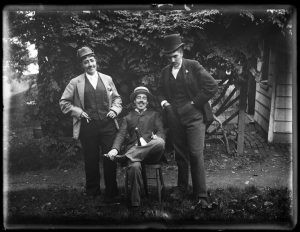
Since its invention, photography, in the simple task of capturing lesbian subjects/activity, was a form of resistance: the keeping of “woman-wholeness in a patriarchal world.” [1] As a medium not widely practiced until the 1850s, and as an art form “not surrounded by entrenched taboos or possessed by the mystique of brotherhood,” photography became a popular occupation for gender nonconforming women. [2] The 1900 U.S. census counted 3580 “professional woman photographers” of which “well over two third were single women and nine were black women,” not counting the “amateur” photographers that were excluded because they didn’t own a studio, regardless if they sold and gained income from their work. [3]
All women photographers transgressed socially acceptable gender norms by choosing to work professionally instead of marrying. However, the prospect of being able to earn enough money to live independently of men likely persuaded lesbians to practice professional photography. These women, such as Emma Jean Gay (1830-1919) and Alice Austen (1866-1952) frequently took pictures of themselves and other women in masculine dress, smoking cigarettes, and taking part in poses suggestive of same-sex desire without being explicitly erotic. [4]
Importantly, these earlier photographers could not and did not label their art as lesbian. Indeed, much of early lesbian photography has likely been lost, never published, or destroyed in order to protect both photographer and subject from homophobia. The majority of these lesbian produced images were likely not traded in the market, but instead shared between photographers and models as personal mementos. [5]
Later, as part of the women’s and gay liberation movement, lesbian artists, including lesbian photographers, would intentionally cultivate a new, explicitly lesbian art genre. [ Learn about Joan E. Biren →]
[1] Nestle, Joan, “Foreword,” in Eye to Eye: Portraits of Lesbians” by Joan E. Biren, Joan E. Biren Papers, Smith College Special Collections, Northampton, MA.
[2] Anne Gottlieb, quoted in “Lesbian Photography” by Judith Schwarz, Eye to Eye, 8.
[3] Schwarz, Judith, “Lesbian Photography,” Eye to Eye, 9.
[4] ibid.
[5] Muzzarelli, Federica. “Women Photographers and Female Identities: Annemarie Schwarzenbach, New Dandy and Lesbian Chic Icon.” Visual Resources: An International Journal of Documentation 34, no. 3/4 (September 2018): 265–92.